 The Two Micron All Sky Survey at IPAC
The Two Micron All Sky Survey at IPAC
|
|
|
 The famous young variable stellar object T Tauri, prototype to the
class of pre-main-sequence objects which bears its name. T Tauri is
actually a 0´´.6-separation binary star, unresolved in this image.
(The objects very near the star just east of north and just west of south are
filter glint artifacts, not infrared companions of T Tau.) The nebula to the
west (NGC 1555) is reflected light from T Tauri.
The famous young variable stellar object T Tauri, prototype to the
class of pre-main-sequence objects which bears its name. T Tauri is
actually a 0´´.6-separation binary star, unresolved in this image.
(The objects very near the star just east of north and just west of south are
filter glint artifacts, not infrared companions of T Tau.) The nebula to the
west (NGC 1555) is reflected light from T Tauri.
(Field size 6.3´ × 8.2´. Image size 184 kB.)
 Extremely Young Stellar Objects in L1551.
The Lynds 1551 (L1551) dark cloud region contains several very young low-mass stellar
objects in the process
of forming stars. At the earliest phases of formation, nascent stars are
deeply embedded in dense dust cores and molecular gas. Their emission is
reprocessed into long-wavelength far-IR and sub-mm radiation. Even at near-IR
wavelengths, the young stars are not detectable as point sources, but
associated nebular and reflected emission can be detected, as in this
2MASS composite three-band image. The early evolution of young stars is
accompanied by at least one episode of jet-like mass loss (Edwards et al.
1986, ApJ, 307, L65).
The bright yellow shrouded source toward the center of the image is the
well-known IRS 5; the reddish object to the northeast is L1551-NE. Both
sources are almost certainly deeply-embedded forming stars. The
blue-greenish emission fanning out to the southwest of IRS 5 is a gas outflow
from that source.
IRS 5 is evolved enough that its jet-like outflow has possibly excavated a
cavity with large opening angle in the ambient medium (Hodapp & Ladd 1995,
ApJ, 453, 715). The oblate shape of
IRS 5 may be due to a circumstellar disk, which is perpendicular to the
outflow (Strom et al. 1985, AJ, 90, 2575).
L1551-NE is likely younger and also has
fan-shaped nebulosity extending to the southwest; but much of the
nebulosity is likely
reflected light, possibly tracing out an outflow-blown cavity.
Extremely Young Stellar Objects in L1551.
The Lynds 1551 (L1551) dark cloud region contains several very young low-mass stellar
objects in the process
of forming stars. At the earliest phases of formation, nascent stars are
deeply embedded in dense dust cores and molecular gas. Their emission is
reprocessed into long-wavelength far-IR and sub-mm radiation. Even at near-IR
wavelengths, the young stars are not detectable as point sources, but
associated nebular and reflected emission can be detected, as in this
2MASS composite three-band image. The early evolution of young stars is
accompanied by at least one episode of jet-like mass loss (Edwards et al.
1986, ApJ, 307, L65).
The bright yellow shrouded source toward the center of the image is the
well-known IRS 5; the reddish object to the northeast is L1551-NE. Both
sources are almost certainly deeply-embedded forming stars. The
blue-greenish emission fanning out to the southwest of IRS 5 is a gas outflow
from that source.
IRS 5 is evolved enough that its jet-like outflow has possibly excavated a
cavity with large opening angle in the ambient medium (Hodapp & Ladd 1995,
ApJ, 453, 715). The oblate shape of
IRS 5 may be due to a circumstellar disk, which is perpendicular to the
outflow (Strom et al. 1985, AJ, 90, 2575).
L1551-NE is likely younger and also has
fan-shaped nebulosity extending to the southwest; but much of the
nebulosity is likely
reflected light, possibly tracing out an outflow-blown cavity.
The two bright stars to the north are the unusual T Tauri stars HL and XZ Tau.
HL Tau has a circumstellar accretion disk (Close et al. 1997, ApJ, 478, 766).
Both stars are associated with HH30 and other Herbig-Haro objects.
The star to the southwest of those two stars is LkH 358.
All of these objects are about 105 years old and at a distance
of about 140 pc (456 light years). Mosaic by E. Kopan (IPAC).
(Field size 14.6´ × 15.1´. Image size 736 kb.)
358.
All of these objects are about 105 years old and at a distance
of about 140 pc (456 light years). Mosaic by E. Kopan (IPAC).
(Field size 14.6´ × 15.1´. Image size 736 kb.)
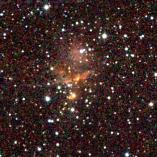 Atlas Image mosaic of the ultracompact HII region
RAFGL 5173, also known as G192.16-03.82 and IRAS 05553+1631. This
region, at a distance of about 2 kpc (6520 light years) from us, has a
luminosity of about 3000 suns, which implies that the region is excited by a
very young mid- to early-type B star with a mass of 5 to 10 times the Sun
(Shepherd et al. 1998, ApJ, 507, 861).
The region is at the center of a very extended pair of Herbig-Haro emission
nebulae, HH 396/397. Herbig-Haro (HH) objects are shock-excited visible
nebulae powered by outflows from young stellar objects; the emission from
HH 396/397, one of the most spatially extended HH complexes, is not
nearly as luminous in the near-infrared. Devine et al. (1999, AJ, 117,
2919) conclude from a
recent combined optical/near-infrared study of this region that its dynamical
age is about 105 years and that it is in a relatively late state of
the evolution of a moderate-mass young stellar object, which will indeed become
an early B-type star. Image mosaic by S. Van Dyk (IPAC).
These data are included in the Second Incremental Release!
(Field size 8.0´ × 8.0´. Image size 288 kb.)
Atlas Image mosaic of the ultracompact HII region
RAFGL 5173, also known as G192.16-03.82 and IRAS 05553+1631. This
region, at a distance of about 2 kpc (6520 light years) from us, has a
luminosity of about 3000 suns, which implies that the region is excited by a
very young mid- to early-type B star with a mass of 5 to 10 times the Sun
(Shepherd et al. 1998, ApJ, 507, 861).
The region is at the center of a very extended pair of Herbig-Haro emission
nebulae, HH 396/397. Herbig-Haro (HH) objects are shock-excited visible
nebulae powered by outflows from young stellar objects; the emission from
HH 396/397, one of the most spatially extended HH complexes, is not
nearly as luminous in the near-infrared. Devine et al. (1999, AJ, 117,
2919) conclude from a
recent combined optical/near-infrared study of this region that its dynamical
age is about 105 years and that it is in a relatively late state of
the evolution of a moderate-mass young stellar object, which will indeed become
an early B-type star. Image mosaic by S. Van Dyk (IPAC).
These data are included in the Second Incremental Release!
(Field size 8.0´ × 8.0´. Image size 288 kb.)
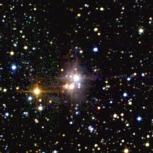 Atlas Image mosaic of a small, stellar cluster in the
constellation Cygnus, consisting of the optically-bright Herbig Be star
BD +40° 4124 (V1685 Cygni=MWC 340; center of image), V1686 Cyg
(LkH
Atlas Image mosaic of a small, stellar cluster in the
constellation Cygnus, consisting of the optically-bright Herbig Be star
BD +40° 4124 (V1685 Cygni=MWC 340; center of image), V1686 Cyg
(LkH 224; southeast of center), and V1318 Cyg (LkH
224; southeast of center), and V1318 Cyg (LkH 225; just east of V1686 Cyg). Herbig Ae/Be stars are
young, intermediate-mass stars exhibiting mass loss, as seen from their
optical line emission. This stellar group is about 1 kpc (3260 light years)
from us, along the Cygnus spiral arm. V1686 Cyg and V1318 Cyg are also
optical emission-line objects. V1318 Cyg, as seen in the 2MASS image, is
actually two objects; Aspen, Sandell, & Weintraub (1994, A&A, 282, L25) suggest
that the pair form a possibly-interacting binary of pre-main-sequence
objects. A water maser source and bipolar molecular outflow are associated
with V1318 Cyg (Palla et al. 1995, A&A, 293, 521).
Many more highly-embedded objects are seen around this
group of stars, which can be seen to be surrounded by infrared-bright
nebulosity; the cluster of objects shows both a significant spread in stellar
mass (both low and high, forming simultaneously) and
age (~3 Myr; Hillenbrand et al. 1995, AJ, 109, 280). The
infrared-bright yellowish star further southeast is unidentified.
Image mosaic by S. Van Dyk (IPAC).
These data are included in the Second Incremental Release!
(Field size 7´ × 7´. Image size 214 kb.)
225; just east of V1686 Cyg). Herbig Ae/Be stars are
young, intermediate-mass stars exhibiting mass loss, as seen from their
optical line emission. This stellar group is about 1 kpc (3260 light years)
from us, along the Cygnus spiral arm. V1686 Cyg and V1318 Cyg are also
optical emission-line objects. V1318 Cyg, as seen in the 2MASS image, is
actually two objects; Aspen, Sandell, & Weintraub (1994, A&A, 282, L25) suggest
that the pair form a possibly-interacting binary of pre-main-sequence
objects. A water maser source and bipolar molecular outflow are associated
with V1318 Cyg (Palla et al. 1995, A&A, 293, 521).
Many more highly-embedded objects are seen around this
group of stars, which can be seen to be surrounded by infrared-bright
nebulosity; the cluster of objects shows both a significant spread in stellar
mass (both low and high, forming simultaneously) and
age (~3 Myr; Hillenbrand et al. 1995, AJ, 109, 280). The
infrared-bright yellowish star further southeast is unidentified.
Image mosaic by S. Van Dyk (IPAC).
These data are included in the Second Incremental Release!
(Field size 7´ × 7´. Image size 214 kb.)
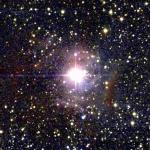 Atlas Image mosaic of the Herbig Be star MWC 297
(IRAS 18250-0351), also known as the variable star NZ Serpentis. In the
near-infrared 2MASS image one can see an extended reflection nebula and dust
clouds around the star. Based on optical-to-near-infrared photometry, the
star is behind ~8 magnitudes of visual extinction, at a distance of 250 pc
(815 ly; Drew et al. 1997, MNRAS, 286, 538).
Bergner et al. (1988, Astrofizica, 28, 529) found from UBVRIJHK
photometry that the star is variable at all wavelengths, likely due to changes
in dust obscuration in the nebula in which the star is still embedded.
Optical spectra by Andrillat & Jaschek (1998, A&AS, 131, 479) show
no absorption lines, only emission lines from the young star's extended
atmosphere, which indicate an underlying spectrum of a massive late O- or
early B-type star. However, spectra by Drew et al. (1997) do show absorption
lines in the blue that allow a spectral typing of B1.5 for the young star and
an estimate of vsin(i) for the star's rotation.
Image mosaic by S. Van Dyk (IPAC).
(Field size 11.7´ × 25.0´. Image size 1.1 Mb!)
Atlas Image mosaic of the Herbig Be star MWC 297
(IRAS 18250-0351), also known as the variable star NZ Serpentis. In the
near-infrared 2MASS image one can see an extended reflection nebula and dust
clouds around the star. Based on optical-to-near-infrared photometry, the
star is behind ~8 magnitudes of visual extinction, at a distance of 250 pc
(815 ly; Drew et al. 1997, MNRAS, 286, 538).
Bergner et al. (1988, Astrofizica, 28, 529) found from UBVRIJHK
photometry that the star is variable at all wavelengths, likely due to changes
in dust obscuration in the nebula in which the star is still embedded.
Optical spectra by Andrillat & Jaschek (1998, A&AS, 131, 479) show
no absorption lines, only emission lines from the young star's extended
atmosphere, which indicate an underlying spectrum of a massive late O- or
early B-type star. However, spectra by Drew et al. (1997) do show absorption
lines in the blue that allow a spectral typing of B1.5 for the young star and
an estimate of vsin(i) for the star's rotation.
Image mosaic by S. Van Dyk (IPAC).
(Field size 11.7´ × 25.0´. Image size 1.1 Mb!)
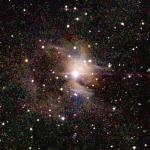 Atlas Image mosaic of the prototypical reflection nebula NGC 7023, aka
the Iris Nebula.
The filamentary structures to the north and south are the edges of molecular
hydrogen gas clouds emitting in the near infrared. A bipolar cavity is seen to
to the east (and north) in this molecular emission (Gerin et al. 1998, ApJ,
500, 329). Rogers, Heyer, & Dewdney (1995, ApJ, 442, 694) indicate that a
bipolar outflow from the young, central Herbig Be star, HD 200775 (the bright
star toward the center of the 2MASS image), is responsible for the formation
of the cavity. Compare the Iris seen here with that in the
optical.
(Field size 15´ × 15´. Image size 848 kb.)
Atlas Image mosaic of the prototypical reflection nebula NGC 7023, aka
the Iris Nebula.
The filamentary structures to the north and south are the edges of molecular
hydrogen gas clouds emitting in the near infrared. A bipolar cavity is seen to
to the east (and north) in this molecular emission (Gerin et al. 1998, ApJ,
500, 329). Rogers, Heyer, & Dewdney (1995, ApJ, 442, 694) indicate that a
bipolar outflow from the young, central Herbig Be star, HD 200775 (the bright
star toward the center of the 2MASS image), is responsible for the formation
of the cavity. Compare the Iris seen here with that in the
optical.
(Field size 15´ × 15´. Image size 848 kb.)
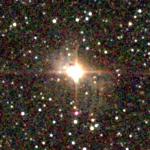 Atlas Image mosaic of the variable star V628
Cassiopeiae, aka MWC 1080. This star is an example of a Herbig Be star,
which are the massive pre-stellar equivalents of the lower-mass
T Tauri stars. V628 Cas has a strong outflow of
matter in the form of a wind. Its optical spectrum is characterized by
intense emission lines, indicating copious circumstellar matter, possibly in a
flat, dense accretion disk (Hillenbrand et al. 1992, ApJ, 397, 613). The star
appears variable, since it is an eclipsing binary system, with a nearly 3-day
period, with periodic 0.16 visual magnitude variations and 0.3-mag irregular
ones (Manset & Bastien 2001, AJ, 122, 3453). The obvious extended emission
seen in the 2MASS image is associated with a known molecular outflow from the
star. The pinkish "star" due south of V628 Cas is actually a known persistence
artifact.
(Field size 5´ × 5´. Image size 137 kb.)
Atlas Image mosaic of the variable star V628
Cassiopeiae, aka MWC 1080. This star is an example of a Herbig Be star,
which are the massive pre-stellar equivalents of the lower-mass
T Tauri stars. V628 Cas has a strong outflow of
matter in the form of a wind. Its optical spectrum is characterized by
intense emission lines, indicating copious circumstellar matter, possibly in a
flat, dense accretion disk (Hillenbrand et al. 1992, ApJ, 397, 613). The star
appears variable, since it is an eclipsing binary system, with a nearly 3-day
period, with periodic 0.16 visual magnitude variations and 0.3-mag irregular
ones (Manset & Bastien 2001, AJ, 122, 3453). The obvious extended emission
seen in the 2MASS image is associated with a known molecular outflow from the
star. The pinkish "star" due south of V628 Cas is actually a known persistence
artifact.
(Field size 5´ × 5´. Image size 137 kb.)
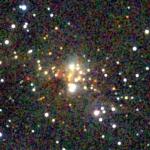 Atlas Image of the region
of the sky containing the red nebulous objects GGD 12-15
(Gyulbudaghian, Glushkov, & Denisyuk 1978, ApJ, 224, L137).
These objects are part of an active star-forming region located in the
Monoceros molecular cloud, about 1 kpc (3260 light years) away. The many
Ks-bright objects in the region appear to be members of a still-forming
star cluster. Associated with this cluster are a strong water maser, a
compact H II region, and a bipolar molecular outflow, all signatures of active
ongoing star formation. Many stellar objects are detected in the 2MASS Atlas
Image. To see a JHKs color-color diagram for the detected point
sources, click here. (The green stellar track is
for dwarfs, the blue track is for giants; Bessell & Brett 1988, PASP, 100,
1134. The reddening vector is from Rieke & Lebofsky 1985, ApJ, 288, 618.) The
embedded objects are obscured by up to at least 10 visual magnitudes of
extinction. These data are included in the Second Incremental Release!
(Field size 8.4´ × 17.1´. Image size 571 kb.)
Atlas Image of the region
of the sky containing the red nebulous objects GGD 12-15
(Gyulbudaghian, Glushkov, & Denisyuk 1978, ApJ, 224, L137).
These objects are part of an active star-forming region located in the
Monoceros molecular cloud, about 1 kpc (3260 light years) away. The many
Ks-bright objects in the region appear to be members of a still-forming
star cluster. Associated with this cluster are a strong water maser, a
compact H II region, and a bipolar molecular outflow, all signatures of active
ongoing star formation. Many stellar objects are detected in the 2MASS Atlas
Image. To see a JHKs color-color diagram for the detected point
sources, click here. (The green stellar track is
for dwarfs, the blue track is for giants; Bessell & Brett 1988, PASP, 100,
1134. The reddening vector is from Rieke & Lebofsky 1985, ApJ, 288, 618.) The
embedded objects are obscured by up to at least 10 visual magnitudes of
extinction. These data are included in the Second Incremental Release!
(Field size 8.4´ × 17.1´. Image size 571 kb.)
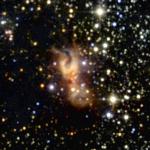 Atlas Image mosaic of GGD 27.
This object is the
center of an active young star formation region obscured optically by dense
molecular gas and dust along our line of sight. In the 2MASS near-infrared
image a number of point sources in this region can be seen, along with the
extended and wispy bipolar reflection nebulosity, which corresponds to a
bipolar molecular outflow, with a dynamical age of about 105 years
(Yamashita et al. 1989, ApJ, 347, 894). Particularly noticeable is the
reddish core region
of the source, where the most embedded star formation is taking place.
Imaging of this core region at slightly longer wavelengths than the 2MASS
bandpasses (3.8 and 4.7 µm) by Aspin et al.
(1994, A&A, 292, L9) reveal several sources so obscured they are not seen
at 2 µm. Image mosaic by S. Van Dyk (IPAC).
(Field size 12.0´ × 12.0´. Image size 510 kb.)
Atlas Image mosaic of GGD 27.
This object is the
center of an active young star formation region obscured optically by dense
molecular gas and dust along our line of sight. In the 2MASS near-infrared
image a number of point sources in this region can be seen, along with the
extended and wispy bipolar reflection nebulosity, which corresponds to a
bipolar molecular outflow, with a dynamical age of about 105 years
(Yamashita et al. 1989, ApJ, 347, 894). Particularly noticeable is the
reddish core region
of the source, where the most embedded star formation is taking place.
Imaging of this core region at slightly longer wavelengths than the 2MASS
bandpasses (3.8 and 4.7 µm) by Aspin et al.
(1994, A&A, 292, L9) reveal several sources so obscured they are not seen
at 2 µm. Image mosaic by S. Van Dyk (IPAC).
(Field size 12.0´ × 12.0´. Image size 510 kb.)
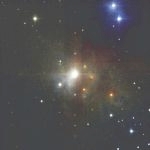 Atlas Image mosaic of the Herbig Ae/Be star
R Coronae Australis. Herbig Ae/Be stars are the intermediate-mass
(2 to 8 solar masses)
counterparts of T Tauri stars. The emission-line star highlights the Corona Australis
molecular cloud complex and is embedded within it.
The complex, at a distance of only ~130 pc
(424 light years) is one of the nearest star-forming regions. The densest
part of the molecular cloud core, containing about 50 solar masses of gas,
has high visual extinction, about 35 magnitudes. The bright star just to
the southeast of R CrA (at image center) is T CrA, and the two stars to the
northeast, enshrouded in bluish reflection nebulosity near the image edge, are
TY CrA (northern-most) and HD 176386 (southern-most). Stars are forming
throughout the cloud, highlighted by
several young stellar objects (YSOs), the most prominent ten or so of which
surrounding R CrA have been dubbed the Coronet; starting clockwise from north
the brighter reddish YSOs comprising the Coronet are IRS 6,
IRS 5, IRS 2, Herbig-Haro (HH) 100 IR, and T Cr A itself.
(The "sources" emanating due north and south of R CrA, with decreasing
brightness are latent image artifacts, produced by the mode of the survey
scanning; diffraction spike artifacts from R CrA are also seen in the image.)
A number
of other fainter YSOs and HH objects (IRS 10 through 15, HH 99, and HH 104)
are also seen; Wilking et al. (1997, AJ, 114, 2029) recently produced a
similar, yet deeper near-infrared map of this region and identified the various
sources in the cloud. They find reflection or HH nebulae associated with most
of the YSOs in the cloud, suggesting nearly coeval star formation in the
cloud some 3 million years ago. They also find a shallower reddening vector
slope than found for normal interstellar dust, implying the presence of larger
than average dust grains throughout the cloud. Image mosaic by S. Van Dyk
(IPAC).
(Field size 10.0´ × 10.0´. Image size 289 kb.)
Atlas Image mosaic of the Herbig Ae/Be star
R Coronae Australis. Herbig Ae/Be stars are the intermediate-mass
(2 to 8 solar masses)
counterparts of T Tauri stars. The emission-line star highlights the Corona Australis
molecular cloud complex and is embedded within it.
The complex, at a distance of only ~130 pc
(424 light years) is one of the nearest star-forming regions. The densest
part of the molecular cloud core, containing about 50 solar masses of gas,
has high visual extinction, about 35 magnitudes. The bright star just to
the southeast of R CrA (at image center) is T CrA, and the two stars to the
northeast, enshrouded in bluish reflection nebulosity near the image edge, are
TY CrA (northern-most) and HD 176386 (southern-most). Stars are forming
throughout the cloud, highlighted by
several young stellar objects (YSOs), the most prominent ten or so of which
surrounding R CrA have been dubbed the Coronet; starting clockwise from north
the brighter reddish YSOs comprising the Coronet are IRS 6,
IRS 5, IRS 2, Herbig-Haro (HH) 100 IR, and T Cr A itself.
(The "sources" emanating due north and south of R CrA, with decreasing
brightness are latent image artifacts, produced by the mode of the survey
scanning; diffraction spike artifacts from R CrA are also seen in the image.)
A number
of other fainter YSOs and HH objects (IRS 10 through 15, HH 99, and HH 104)
are also seen; Wilking et al. (1997, AJ, 114, 2029) recently produced a
similar, yet deeper near-infrared map of this region and identified the various
sources in the cloud. They find reflection or HH nebulae associated with most
of the YSOs in the cloud, suggesting nearly coeval star formation in the
cloud some 3 million years ago. They also find a shallower reddening vector
slope than found for normal interstellar dust, implying the presence of larger
than average dust grains throughout the cloud. Image mosaic by S. Van Dyk
(IPAC).
(Field size 10.0´ × 10.0´. Image size 289 kb.)
 Atlas Image mosaic of the reflection nebula
IC 2087. The bluish nebula has a arc-like appearance, fanning off to
the east from the low-mass young stellar object (YSO) Elias 18 (aka Elias 3-18
and IRAS 04369+2539), within the Taurus molecular cloud, specifically the
Heiles Cloud 2. Elias (1978, ApJ, 224, 857) found that this YSO is behind
about 17 visual magnitudes of extinction. Shuping et al. (2001, ApJ, 547, L161)
argue, based on near-infrared spectroscopy, that, since Elias 18 is associated
with two Herbig-Haro objects (HH 395A and B) to the northeast (not seen in this
image) and IC 2087, the YSO is near the front of Heiles Cloud 2 and that most
of this extinction is in the form of a highly-inclined circumstellar disk
around the YSO. Elias 18 has Ks=6.25, J-H=2.63,
H-Ks=1.78 mag. Known diffraction
spike artifacts are evident around, and persistence artifacts trail (in
decreasing brightness) both due north and due south of, Elias 18. The
infrared-bright source to the southwest in the 2MASS mosaic is the YSO TMC 1A
(IRAS 04365+2535). Image mosaic by S. Van Dyk (IPAC).
(Field size 12´ × 12´. Image size 583 kb.)
Atlas Image mosaic of the reflection nebula
IC 2087. The bluish nebula has a arc-like appearance, fanning off to
the east from the low-mass young stellar object (YSO) Elias 18 (aka Elias 3-18
and IRAS 04369+2539), within the Taurus molecular cloud, specifically the
Heiles Cloud 2. Elias (1978, ApJ, 224, 857) found that this YSO is behind
about 17 visual magnitudes of extinction. Shuping et al. (2001, ApJ, 547, L161)
argue, based on near-infrared spectroscopy, that, since Elias 18 is associated
with two Herbig-Haro objects (HH 395A and B) to the northeast (not seen in this
image) and IC 2087, the YSO is near the front of Heiles Cloud 2 and that most
of this extinction is in the form of a highly-inclined circumstellar disk
around the YSO. Elias 18 has Ks=6.25, J-H=2.63,
H-Ks=1.78 mag. Known diffraction
spike artifacts are evident around, and persistence artifacts trail (in
decreasing brightness) both due north and due south of, Elias 18. The
infrared-bright source to the southwest in the 2MASS mosaic is the YSO TMC 1A
(IRAS 04365+2535). Image mosaic by S. Van Dyk (IPAC).
(Field size 12´ × 12´. Image size 583 kb.)
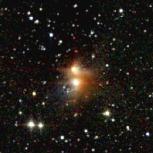 Atlas Image mosaic of the Herbig Ae/Be star
LkH
Atlas Image mosaic of the Herbig Ae/Be star
LkH 198, at a distance of 600 to 900 pc.
The Herbig Ae/Be stars are intermediate-mass pre-main sequence objects,
showing emission lines in their optical spectra and appearing with associated
nebulosity (they are more massive than their lower-mass counterparts, the
T Tauri stars).
LkH
198, at a distance of 600 to 900 pc.
The Herbig Ae/Be stars are intermediate-mass pre-main sequence objects,
showing emission lines in their optical spectra and appearing with associated
nebulosity (they are more massive than their lower-mass counterparts, the
T Tauri stars).
LkH 198 is the bright object at the center of the image;
35´´ north of this star is another
Ae/Be star, V376 Cas. Both stars can be seen in the near-infrared to
be embedded in associated nebulous clouds. (Diffraction spike artifacts can
be seen emanating from both bright objects; latent image artifacts, produced by the mode of the survey scanning, show a
similar pattern of "red stars" both due north and due south of the two stars.)
Both stars are thought to drive a low-velocity bipolar molecular outflow.
LkH
198 is the bright object at the center of the image;
35´´ north of this star is another
Ae/Be star, V376 Cas. Both stars can be seen in the near-infrared to
be embedded in associated nebulous clouds. (Diffraction spike artifacts can
be seen emanating from both bright objects; latent image artifacts, produced by the mode of the survey scanning, show a
similar pattern of "red stars" both due north and due south of the two stars.)
Both stars are thought to drive a low-velocity bipolar molecular outflow.
LkH 198 also has an embedded infrared companion (unseen
in the 2MASS image). Also seen in the 2MASS image is a blue elliptical loop
associated with LkH
198 also has an embedded infrared companion (unseen
in the 2MASS image). Also seen in the 2MASS image is a blue elliptical loop
associated with LkH 198 and a similar "sickle-shaped"
nebula (weakly) seen to the west of V376 Cas; this extended emission is
consistent with light scattering by small dust grains. A diagram of this
complex region, showing the relationship of its various components, is
provided by Koresko et al. (1997, ApJ, 485, 213; their Figure 7).
Image mosaic by S. Van Dyk (IPAC).
(Field size 6.7´ × 6.7´. Image size 188 kb.)
198 and a similar "sickle-shaped"
nebula (weakly) seen to the west of V376 Cas; this extended emission is
consistent with light scattering by small dust grains. A diagram of this
complex region, showing the relationship of its various components, is
provided by Koresko et al. (1997, ApJ, 485, 213; their Figure 7).
Image mosaic by S. Van Dyk (IPAC).
(Field size 6.7´ × 6.7´. Image size 188 kb.)
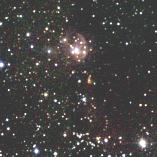 Atlas Image mosaic of the star
LkH
Atlas Image mosaic of the star
LkH 221, a probable pre-main-sequence
emission-line (T Tauri) star (Weintraub
1990, ApJS, 74, 575). Image mosaic by S. Van Dyk (IPAC).
(Field size 8.0´ × 8.0´. Image size 254 kb.)
221, a probable pre-main-sequence
emission-line (T Tauri) star (Weintraub
1990, ApJS, 74, 575). Image mosaic by S. Van Dyk (IPAC).
(Field size 8.0´ × 8.0´. Image size 254 kb.)
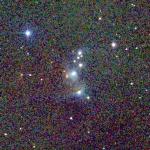 Atlas Image mosaic of the infrared source
LDN 1641 S 4.
This object, also known as GGD 7 (Gyulbudaghian, Glushkov, & Denisyuk 1978,
ApJ, 224, L137), at a possible distance of about 500 pc, is part of a group of
nebulae in Lynds dark cloud (LDN) 1641,
in the Orion complex. The region was previously imaged in the near-infrared
by Carballo, Eiroa, & Mampaso (1988, MNRAS, 232, 497); they identified five
infrared sources (IRS 1-5) in this field. These sources are the five brightest
clustered toward the center of the 2MASS image. Four of the sources (IRS 1-4)
are clearly embedded in nebulosity. A dark dust lane runs between IRS 3 and 4.
Carballo et al. suspected that IRS 1-3 were variable; comparison of their
JHK photometry with the 2MASS values comfirms this, as well as possible
variability for IRS 5. Carballo et al. concluded that IRS 2 and 3 are likely
pre-main-sequence stars. Clearly, from the 2MASS image, there are many more
stellar sources embedded in this dark cloud of young pre-stellar objects, some
(the reddest ones) obscured by more than 20 visual magnitudes of extinction.
Image mosaic by S. Van Dyk (IPAC). These data are included in the Second
Incremental Release! (Field size 10.0´ × 10.0´.
Image size 449 kb.)
Atlas Image mosaic of the infrared source
LDN 1641 S 4.
This object, also known as GGD 7 (Gyulbudaghian, Glushkov, & Denisyuk 1978,
ApJ, 224, L137), at a possible distance of about 500 pc, is part of a group of
nebulae in Lynds dark cloud (LDN) 1641,
in the Orion complex. The region was previously imaged in the near-infrared
by Carballo, Eiroa, & Mampaso (1988, MNRAS, 232, 497); they identified five
infrared sources (IRS 1-5) in this field. These sources are the five brightest
clustered toward the center of the 2MASS image. Four of the sources (IRS 1-4)
are clearly embedded in nebulosity. A dark dust lane runs between IRS 3 and 4.
Carballo et al. suspected that IRS 1-3 were variable; comparison of their
JHK photometry with the 2MASS values comfirms this, as well as possible
variability for IRS 5. Carballo et al. concluded that IRS 2 and 3 are likely
pre-main-sequence stars. Clearly, from the 2MASS image, there are many more
stellar sources embedded in this dark cloud of young pre-stellar objects, some
(the reddest ones) obscured by more than 20 visual magnitudes of extinction.
Image mosaic by S. Van Dyk (IPAC). These data are included in the Second
Incremental Release! (Field size 10.0´ × 10.0´.
Image size 449 kb.)
 Atlas Image mosaic of the molecular outflow source
and star forming region W75N (also known as Cyg X FIR 33). W75N is embedded
in a molecular cloud, at ~2 kpc distance from us, that is part of the larger
complex of dense molecular clouds known as Cygnus X. Previous near-infrared
imaging of W75N, made with a 7.8´´ circular beam, revealed a number
of continuum sources and extended 2 µm-bright reflection nebula
(Moore et al. 1988, MNRAS, 234, 95) or nebulae (Moore et al. 1991, MNRAS, 248,
377). Although the properties of the embedded luminous sources cannot be
directly assessed, but must be gathered from the reflected nebular light,
the bright continuum sources are likely ultracompact HII regions,
containing one or more very young massive stars, and comprise a recently-formed
cluster of stars in W75. The extinction in the nebulae toward the embedded
sources is at least visual magnitude 15, but may be > 100 in the densest
regions (Moore et al. 1991). 2MASS has covered the Cygnus X region
and included much of it in the Second Incremental Data Release.
Image mosaic by S. Van Dyk (IPAC). (Field size 5.0´ × 5.0´.
Image size 136 kb.)
Atlas Image mosaic of the molecular outflow source
and star forming region W75N (also known as Cyg X FIR 33). W75N is embedded
in a molecular cloud, at ~2 kpc distance from us, that is part of the larger
complex of dense molecular clouds known as Cygnus X. Previous near-infrared
imaging of W75N, made with a 7.8´´ circular beam, revealed a number
of continuum sources and extended 2 µm-bright reflection nebula
(Moore et al. 1988, MNRAS, 234, 95) or nebulae (Moore et al. 1991, MNRAS, 248,
377). Although the properties of the embedded luminous sources cannot be
directly assessed, but must be gathered from the reflected nebular light,
the bright continuum sources are likely ultracompact HII regions,
containing one or more very young massive stars, and comprise a recently-formed
cluster of stars in W75. The extinction in the nebulae toward the embedded
sources is at least visual magnitude 15, but may be > 100 in the densest
regions (Moore et al. 1991). 2MASS has covered the Cygnus X region
and included much of it in the Second Incremental Data Release.
Image mosaic by S. Van Dyk (IPAC). (Field size 5.0´ × 5.0´.
Image size 136 kb.)
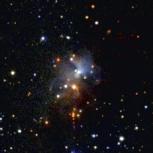 Atlas Image Mosaic of the Serpens Nebula star
formation
region. This region, at a distance of only 310 pc (1011 light years; De Lara
et al. 1991, A&A, 243, 139), is a reflection nebula around a cluster of very
young stars embedded in the natal molecular cloud. It is also collection of
molecular outflows from these young stellar objects; Hurt & Barsony (1996, ApJ,
460, L45) found examples of the short-lived earliest protostellar stage.
The Serpens molecular cloud is one of the most spectacular protostellar
nurseries in the Milky Way Galaxy, with a very high stellar density
(Eiroa & Casali 1992, A&A, 262, 468).
Giovannetti et al. (1998, A&A, 330, 990) found from near-infrared
imaging of the nebula that two recent bursts of star formation have occurred,
one 105 years ago, and the other is around
3 × 106 years ago. (Field size 9.0´ × 9.0´.
Image size 280 kb.)
Atlas Image Mosaic of the Serpens Nebula star
formation
region. This region, at a distance of only 310 pc (1011 light years; De Lara
et al. 1991, A&A, 243, 139), is a reflection nebula around a cluster of very
young stars embedded in the natal molecular cloud. It is also collection of
molecular outflows from these young stellar objects; Hurt & Barsony (1996, ApJ,
460, L45) found examples of the short-lived earliest protostellar stage.
The Serpens molecular cloud is one of the most spectacular protostellar
nurseries in the Milky Way Galaxy, with a very high stellar density
(Eiroa & Casali 1992, A&A, 262, 468).
Giovannetti et al. (1998, A&A, 330, 990) found from near-infrared
imaging of the nebula that two recent bursts of star formation have occurred,
one 105 years ago, and the other is around
3 × 106 years ago. (Field size 9.0´ × 9.0´.
Image size 280 kb.)
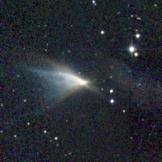 Atlas Image mosaic of the Chamaeleon infrared nebula
(IRAS 11072-7727), which is a bipolar reflection nebula in the Cha I dark
cloud. The nebula is at a distance from us of about 190 pc (619 light years).
Feldt et al. (1998, A&A, 332, 849) recently imaged the nebula in the
near-infrared. They describe the nebula as outlining two parabolic cavities
excavated by outflow activity. The overall morphology of the nebula in the
near-IR provided Feldt et al. with evidence that the bright source at the
center contains a tilted disk surrounding a very young binary star system.
Image mosaic by S. Van Dyk (IPAC).
(Field size 10.0´ × 10.0´. Image size 338 kb.)
Atlas Image mosaic of the Chamaeleon infrared nebula
(IRAS 11072-7727), which is a bipolar reflection nebula in the Cha I dark
cloud. The nebula is at a distance from us of about 190 pc (619 light years).
Feldt et al. (1998, A&A, 332, 849) recently imaged the nebula in the
near-infrared. They describe the nebula as outlining two parabolic cavities
excavated by outflow activity. The overall morphology of the nebula in the
near-IR provided Feldt et al. with evidence that the bright source at the
center contains a tilted disk surrounding a very young binary star system.
Image mosaic by S. Van Dyk (IPAC).
(Field size 10.0´ × 10.0´. Image size 338 kb.)
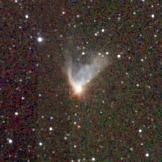 Atlas Image mosaic of Hubble's Variable Nebula, consisting
of the infrared source R Monocerotis and the nebula NGC 2261.
R Mon is thought to be a relatively young pre-main sequence star, and NGC 2261
is one lobe of a bipolar outflow from R Mon (Aspin et al. 1988, A&A, 197, 242).
The core and nebula are both highly variable, on the timescales of a few months
or more. The high infrared excess from R Mon, as seen in the 2MASS image,
is thought to arise from a dust disk around the young star that is reradiating
its optical light into the infrared (Imhoff & Mendoza 1974, RevMAA, 1, 25).
Aspin et al. (1988) provided the first high-resolution near-IR images of R Mon,
showing an interesting eastern jet from the star at 3.6 µm, which is
probably the inner hot regions of the circumstellar disk. (The "star" trailing
to the south is a Ks-bright known persistence artifact; also seen
are the prominent diffraction spike artifacts.) Image mosaic by S. Van Dyk
(IPAC). (Field size 6.0´ × 6.0´. Image size 157 kb.)
Atlas Image mosaic of Hubble's Variable Nebula, consisting
of the infrared source R Monocerotis and the nebula NGC 2261.
R Mon is thought to be a relatively young pre-main sequence star, and NGC 2261
is one lobe of a bipolar outflow from R Mon (Aspin et al. 1988, A&A, 197, 242).
The core and nebula are both highly variable, on the timescales of a few months
or more. The high infrared excess from R Mon, as seen in the 2MASS image,
is thought to arise from a dust disk around the young star that is reradiating
its optical light into the infrared (Imhoff & Mendoza 1974, RevMAA, 1, 25).
Aspin et al. (1988) provided the first high-resolution near-IR images of R Mon,
showing an interesting eastern jet from the star at 3.6 µm, which is
probably the inner hot regions of the circumstellar disk. (The "star" trailing
to the south is a Ks-bright known persistence artifact; also seen
are the prominent diffraction spike artifacts.) Image mosaic by S. Van Dyk
(IPAC). (Field size 6.0´ × 6.0´. Image size 157 kb.)
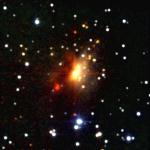 Atlas Image Mosaic of the infrared source
NGC 2264 IRS1, which is part of the larger NGC 2264 star-forming region.
The source is a very young intermediate-mass star, still embedded in its
natal cloud, just north of the tip of the famous Cone Nebula (for a beautiful
optical view of the field by David Malin, visit this
page). The
bright optical star W 178 can be seen just to south of the source; the nebulous
tip of the optical Cone can also be seen in the 2MASS image, just to the
southeast. The source was previously imaged in the near-infrared by
Schreyer et al. (1997, A&A, 326, 347), and they noted a jet-like feature
to the northeast of IRS1, and also the infrared-bright (Ks-only)
compact cluster immediately to the southeast. IRS1 is surrounded by a cluster
of embedded lower-mass stars. Another cluster of embedded stars can be seen
~6´ to the northwest in the 2MASS image. IRS1 and its neighbors are
all part of the larger Monoceros OB1 cloud complex, where stars are actively
forming.
(Field size 15.0´ × 15.0´. Image size 607 kb.)
Atlas Image Mosaic of the infrared source
NGC 2264 IRS1, which is part of the larger NGC 2264 star-forming region.
The source is a very young intermediate-mass star, still embedded in its
natal cloud, just north of the tip of the famous Cone Nebula (for a beautiful
optical view of the field by David Malin, visit this
page). The
bright optical star W 178 can be seen just to south of the source; the nebulous
tip of the optical Cone can also be seen in the 2MASS image, just to the
southeast. The source was previously imaged in the near-infrared by
Schreyer et al. (1997, A&A, 326, 347), and they noted a jet-like feature
to the northeast of IRS1, and also the infrared-bright (Ks-only)
compact cluster immediately to the southeast. IRS1 is surrounded by a cluster
of embedded lower-mass stars. Another cluster of embedded stars can be seen
~6´ to the northwest in the 2MASS image. IRS1 and its neighbors are
all part of the larger Monoceros OB1 cloud complex, where stars are actively
forming.
(Field size 15.0´ × 15.0´. Image size 607 kb.)
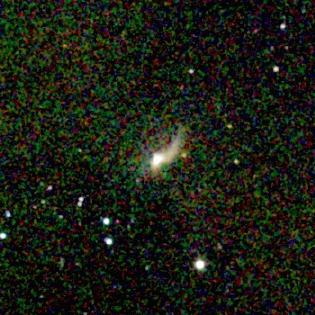 The young stellar outflow Herbig-Haro 31.
(Field size 5.8´ × 5.8´. Image size 171 kb.)
The young stellar outflow Herbig-Haro 31.
(Field size 5.8´ × 5.8´. Image size 171 kb.)
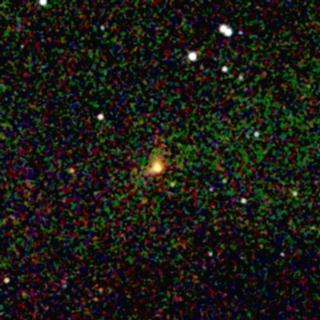 The young stellar outflow Herbig-Haro 300.
(Field size 5.3´ × 5.3´. Image size 156 kb.)
The young stellar outflow Herbig-Haro 300.
(Field size 5.3´ × 5.3´. Image size 156 kb.)
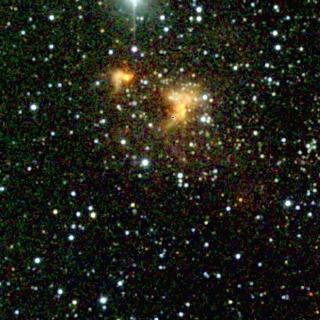 The molecular outflow RAFGL 6366S.
(Field size 8.2´ × 8.2´. Image size 287 kb.)
The molecular outflow RAFGL 6366S.
(Field size 8.2´ × 8.2´. Image size 287 kb.)
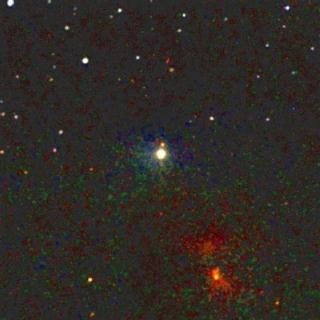 The molecular outflow LDN 1535.
(Field size 7.3´ × 7.3´. Image size 171 kb.)
The molecular outflow LDN 1535.
(Field size 7.3´ × 7.3´. Image size 171 kb.)
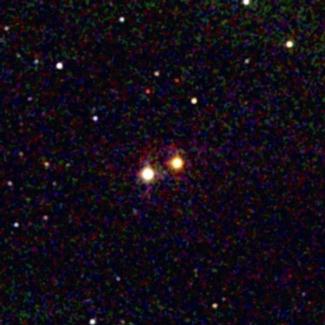 The young stellar object Haro 6-13.
(Field size 5.4´ × 5.4´. Image size 149 kb.)
The young stellar object Haro 6-13.
(Field size 5.4´ × 5.4´. Image size 149 kb.)
 The young stellar objects GGD 4.
(Field size 6.7´ × 6.7´. Image size 145 kb.)
The young stellar objects GGD 4.
(Field size 6.7´ × 6.7´. Image size 145 kb.)
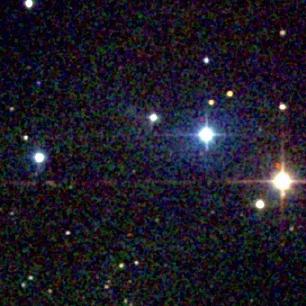 The stars V892 and V1023 Tauri.
(Field size 5.7´ × 5.7´. Image size 153 kb.)
The stars V892 and V1023 Tauri.
(Field size 5.7´ × 5.7´. Image size 153 kb.)
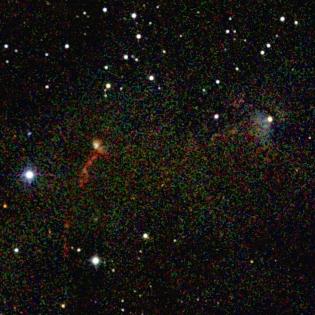 The young stellar objects L1448C and RNO 13.
(Field size 12.5´ × 10.5´. Image size 532 kb.)
The young stellar objects L1448C and RNO 13.
(Field size 12.5´ × 10.5´. Image size 532 kb.)
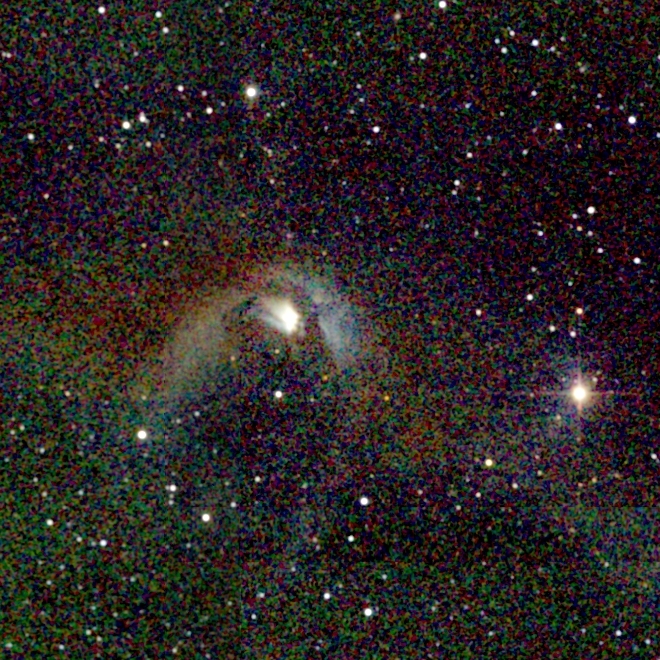 The emission-line star RNO 91.
(Field size 11.0´ × 11.0´. Image size 520 kb.)
The emission-line star RNO 91.
(Field size 11.0´ × 11.0´. Image size 520 kb.)
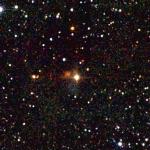 Atlas Image mosaic of the
emission-line star V1735 Cygni, aka Elias 1-12 and IRAS 21454+4718.
he star is a FU Orionis-like variable discovered by Elias (1978, ApJ, 223,
859). FU Ori stars are protostellar, or pre-main sequence, objects likely
surrounded by a disk of accreting matter, with an outflowing, outbursting wind.
These objects are similar to T Tauri.
V1735 Cyg is heavily embedded in a dark molecular cloud, also associated with
the nebula and young stellar cluster IC 5146.
Image mosaic by S. Van Dyk (IPAC).
(Field size 8´ × 8´. Image size 278 kb.)
Atlas Image mosaic of the
emission-line star V1735 Cygni, aka Elias 1-12 and IRAS 21454+4718.
he star is a FU Orionis-like variable discovered by Elias (1978, ApJ, 223,
859). FU Ori stars are protostellar, or pre-main sequence, objects likely
surrounded by a disk of accreting matter, with an outflowing, outbursting wind.
These objects are similar to T Tauri.
V1735 Cyg is heavily embedded in a dark molecular cloud, also associated with
the nebula and young stellar cluster IC 5146.
Image mosaic by S. Van Dyk (IPAC).
(Field size 8´ × 8´. Image size 278 kb.)
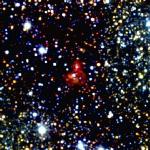 Atlas Image mosaic of IRAS 17244-3536, which
appears to be a region of high gas density and a source of
CS molecular emission (Chan, Henning, & Streyer 1996, A&AS, 115, 285),
where one or more young massive stellar objects are forming.
Little else is known about IRAS 17244-3536.
Image mosaic by S. Van Dyk (IPAC).
(Field size 6´ × 6´. Image size 278 kb.)
Atlas Image mosaic of IRAS 17244-3536, which
appears to be a region of high gas density and a source of
CS molecular emission (Chan, Henning, & Streyer 1996, A&AS, 115, 285),
where one or more young massive stellar objects are forming.
Little else is known about IRAS 17244-3536.
Image mosaic by S. Van Dyk (IPAC).
(Field size 6´ × 6´. Image size 278 kb.)
 The embedded young star cluster IRAS 20050+2720,
the bright agglomeration of stars near the center of
the 2MASS three-color image. This cluster has been recently
studied by Chen et al. (1997, ApJ, 475, 163). The cluster appears to consist
of several subclusterings, three of which were studied by Chen et al.; there
appear to be several other subclusterings not included in their near-IR
imaging. The IRAS source itself is the
brightest, reddest southern subclustering ("Subcluster A").
Some reflection nebulosity is
associated with the cluster stars. Chen et al. find an extinction to
the cluster of AV ~ 10, although the extinction is clearly higher
for subcluster A. (It is also clear from the 2MASS image that
significant extinction is distributed throughout this field.)
More than half of the point sources in the
cluster appear to show an infrared excess beyond this extinction,
indicating that we may be seeing thermal dust emission from circumstellar disks
around classical T Tauri stars. These sources are therefore likely pre-main
sequence objects. Chen et al. find that the slope and turnover of the K-band
luminosity function imply an overall age for this cluster of ~1 Myr, although
the subclusters are of somewhat different ages. The IRAS source
"subcluster A" is also associated with dense molecular gas as traced by
millimeter radio observations and coincides with the center of
a multipolar outflow with a dynamical age of only 103 to
104 yr.
(Field size 8.2´ × 14.5´. Image size 511 kb.)
The embedded young star cluster IRAS 20050+2720,
the bright agglomeration of stars near the center of
the 2MASS three-color image. This cluster has been recently
studied by Chen et al. (1997, ApJ, 475, 163). The cluster appears to consist
of several subclusterings, three of which were studied by Chen et al.; there
appear to be several other subclusterings not included in their near-IR
imaging. The IRAS source itself is the
brightest, reddest southern subclustering ("Subcluster A").
Some reflection nebulosity is
associated with the cluster stars. Chen et al. find an extinction to
the cluster of AV ~ 10, although the extinction is clearly higher
for subcluster A. (It is also clear from the 2MASS image that
significant extinction is distributed throughout this field.)
More than half of the point sources in the
cluster appear to show an infrared excess beyond this extinction,
indicating that we may be seeing thermal dust emission from circumstellar disks
around classical T Tauri stars. These sources are therefore likely pre-main
sequence objects. Chen et al. find that the slope and turnover of the K-band
luminosity function imply an overall age for this cluster of ~1 Myr, although
the subclusters are of somewhat different ages. The IRAS source
"subcluster A" is also associated with dense molecular gas as traced by
millimeter radio observations and coincides with the center of
a multipolar outflow with a dynamical age of only 103 to
104 yr.
(Field size 8.2´ × 14.5´. Image size 511 kb.)
 Atlas Image mosaic of the infrared source
IRAS 22051+5848, seen south of center in the 2MASS image. This source,
at a distance of about 750 pc (2445 light
years), is a pre-main sequence star reaching the end of an active FU Orionis
phase and is embedded in the dark cloud LDN 1165. The fan-like nebula
immediately to the southwest is GY 22, and is likely a reflection
nebula, scattering light from IRAS 22051+5848. The IRAS source is also
the origin of Herbig-Haro (HH) object 354 (not seen in the 2MASS image), an
outflow which is unusually separated by a large distance (2.4 pc, or 7.8 light
years) from its source (Reipurth, Bally, & Devine 1997, AJ, 114, 2708). The
brighter reddish star at the center of the 2MASS image is IRAS 22051+5849,
which is also embedded in the same cloud, but is unlikely the source of HH 354.
Image mosaic by S. Van Dyk (IPAC).
(Field size 8.0´ × 8.0´. Image size 293 kb.)
Atlas Image mosaic of the infrared source
IRAS 22051+5848, seen south of center in the 2MASS image. This source,
at a distance of about 750 pc (2445 light
years), is a pre-main sequence star reaching the end of an active FU Orionis
phase and is embedded in the dark cloud LDN 1165. The fan-like nebula
immediately to the southwest is GY 22, and is likely a reflection
nebula, scattering light from IRAS 22051+5848. The IRAS source is also
the origin of Herbig-Haro (HH) object 354 (not seen in the 2MASS image), an
outflow which is unusually separated by a large distance (2.4 pc, or 7.8 light
years) from its source (Reipurth, Bally, & Devine 1997, AJ, 114, 2708). The
brighter reddish star at the center of the 2MASS image is IRAS 22051+5849,
which is also embedded in the same cloud, but is unlikely the source of HH 354.
Image mosaic by S. Van Dyk (IPAC).
(Field size 8.0´ × 8.0´. Image size 293 kb.)
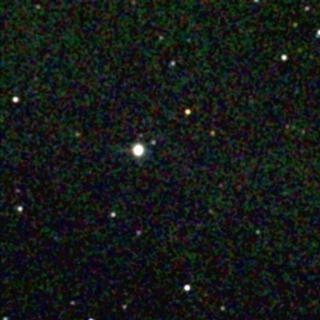 The pre-main-sequence star HK Tauri.
(Field size 5.3´ × 5.3´. Image size 142 kb.)
The pre-main-sequence star HK Tauri.
(Field size 5.3´ × 5.3´. Image size 142 kb.)
 The young stellar objects FS Tau A and B.
(Field size 5.5´ × 5.5´. Image size 155 kb.)
The young stellar objects FS Tau A and B.
(Field size 5.5´ × 5.5´. Image size 155 kb.)
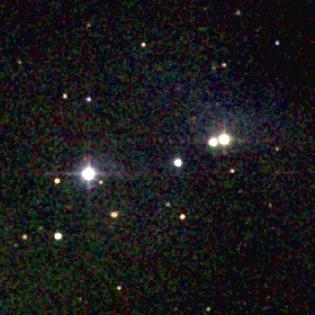 The young stellar objects DG Tau, DG Tau B, FV Tau.
(Field size 5.8´ × 5.8´. Image size 161 kb.)
The young stellar objects DG Tau, DG Tau B, FV Tau.
(Field size 5.8´ × 5.8´. Image size 161 kb.)
Return to 2MASS Image Gallery Homepage